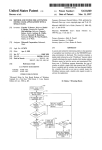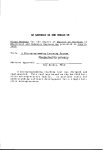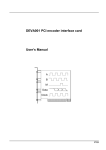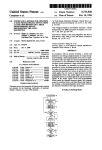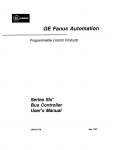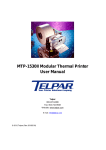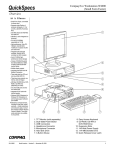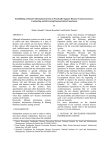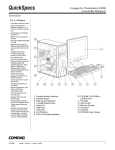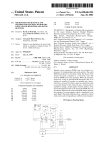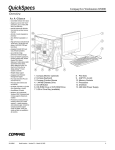Download Data processor
Transcript
USOO530546OA United States Patent [19] [11] [45] Kaneko et a1. [54] DATA PROCESSOR [75] Inventors: Susumu Kaneko, Kodaira; Keiichi Kurakazu, Tachikawa, both of Japan [73] Assignee: Hitachi, Ltd., Tokyo, Japan [21] Appl. No.: 254,267 [22] Filed: [30] [51] [52] Japan .................................... ., 255180 364/232.8; 364/232.9; 364/245.7; 364/245.8; 364/246.9 364/200 MS File, 900 MS File; 395/775, 575, 425 References Cited U.S. PATENT DOCUMENTS Re. 28,109 3,828,327 4,393,459 8/1974 Provenzano et a1. ............. .. 364/900 8/1974 Berglund et a]. ......... .. 364/200 7/1983 Huntley et a]. . 4,519,032 5/1985 4,628,448 12/1986 Mendel] .... .. Murao ............... .. 364/900 395/725 364/200 4,783,731 11/1988 Miyazaki et a1. 364/200 4,825,358 364/200 4/1989 Letwin .............. .. 4,887,204 12/1989 Johnson et a1. ............... 68000 Hitachi Microcomputer IBM Technical Disclosure Bulletin, vol. 28, No. 10, Mar. 1986, PP- 4538-4539. Primary Examiner—Debra A. Chun Attorney, Agent, or Firm-Fay, Sharpe, Beall, Fagan, Minnich & McKee [57] ABSTRACT In a microcomputer having two program execution states including a supervisor state and a user state, there is disposed a flag or a register having such a flag indicat ing whether or not a RAM area used in the supervisor state can be used in the user state by the CPU. A judge circuit determines whether or not the CPU has made an attempt to invalidly access the RAM in the user state based on the content of the ?ag or the register and that of the supervisor/user state specify bit in the status register. In a case of an occurrence of an access viola tion, a violation signal is sent to the CPU and the selec tion signal of the RAM is disabled (to be set to an inef 364/200 fective state), thereby increasing the reliability of the system. System 30 Claims, 4 Drawing Sheets OTHER PUBLICATIONS “HMCS Motorola Inc., Second Edition, Prentice-Hall Inc., 1985, pp. l-l, l-2, l-4, 6-1, 6-2, and 6-3. Borivoje Furht, et al., “A Survey of Microprocessor “Protection Scheme for Non-Key Storage Systems”, Int. Cl; ....................... .. G06F 9/00; G06F 12/14 us. 01. ........................... .. 395/775; 364/DIG. 1; [56] HD68000, HD68000Y, HD68000P, HD68000PS Micro Processing Unit (MPU)”, Sep, 1984, p. 52. _“MC68020 32-Bit Microprocessor User’s Manual”, vol. 20, No. 3, Mar. 1987, pp. 48-67. Foreign Application Priority Data [58] Field of Search Apr. 19, 1994 Architecture for Memory Management”, Computer, Oct. 5, 1988 Oct. 9, 1987 [JP] 5,305,460 Patent Number: Date of Patent: / MCU I 3 msmucnou REGISTER It MICRO -ROM 5 comm orconea EXECUTION UNlT US. Patent Apr. 19, 1994 Sheet 2 of 4 FIG. 2 CPU S/U SR ADDRESS COMPARATOR ~17 G3 5,305,460 1 5,305,460 2 is sent to the CPU and a selection signal of the RAM is DATA PROCESSOR disabled (is set to the invalid state). According to the means above, in a case where it is BACKGROUND OF THE INVENTION The present invention relates to a data processing desired that the CPU uses the RAM in the supervisor state in order to keep the data protected in the RAM, a state preventing an access is set to the new flag or regis ter thus disposed. This automatically prevents an access technology, and in particular, to a technology that is particularly effective when applied to a data processor having a higher operation mode and a lower operation mode, for example, to a technology effectively applied to the associated RAM in the user state so as to prevent destruction or a read operation of important data; or, so that a restoration of data destroyed by an exception to a control method of a memory in a microcomputer. Conventionally, a processor may have two program processing or the like is enabled, thereby achieving the objects above to improve the reliability of the system. state and an operation mode called a user state, where Above and other objects and novel features of the the processor is capable of operating either of the two present invention will become apparent from the fol states. For example, microprocessors similar to the 16 5 lowing detailed description taken in conjunction with bit microprocessor HD68000 of Hitachi Ltd. operate in the accompanying drawings. execution states, an operation mode called a supervisor this manner. (For details refer to page 52 of the “HMCS 68000 Hitachi Microcomputer System HD68000, BRIEF DESCRIPTION OF THE DRAWINGS FIG. 1 is a block diagram schematically showing a HD68000Y, HD6800PHD, HD68000PS Micro Pro cessing Unit (MPU)".) ?rst embodiment in a case where the present invention The supervisor state is a higher state of the processor program execution states and the central processing is applied to a microprocessor; FIG. 2 is a block diagram schematically showing a unit (CPU) can use any instructions and can access any registers in this state. The user state is a lower state of the program execution states and the CPU is not al second embodiment in a case where the present inven tion is applied to a microprocessor; FIG. 3 is a block diagram schematically showing the lowed to use the instructions and registers which third embodiment in a case where the present invention greatly affect the system in this state. Namely, in the supervisor state, the CPU can execute a predetermined instruction which the CPU cannot execute in the user state. is applied to the microprocessor, and FIG. 4 is a con?guration diagram showing a bit con 3O ?guration example of a bank mode register including an access level specify bit of the integrated RAM. As described above, with the provision of two pro gram execution states, the microprocessor can more DESCRIPTION OF THE PREFERRED EMBODIMENTS efficiently execute a multitask processing and the like. Incidentally, in microcomputers having the two pro gram execution states as described above, a bit is ordi 35 narily disposed in a status register of the CPU for the purpose of indicating whether the processor is in the FIG. 1 shows an embodiment in which the present invention is applied to a microprocessor having an inte grated RAM. supervisor state or the user state. This would be used to Although not particularly limited to, each circuit indicate the current program execution state. block enclosed with dot-and-dash lines in FIG. 1 is However, in the case where for example, a data ac 40 formed on a single semiconductor chip such as a mono cess device such as a RAM is integrated in a micro crystalline silicon substrate. processor having the two program execution states, the following problem may arise. Where a CPU uses the integrated RAM as the data area while in the supervisor state, it is feared that in some cases important data may 45 be destroyed if the CPU mistakenly accesses this data area while in the user state. The microprocessor of this embodiment is provided with a central processing unit (CPU) operating accord ing to the microprogram control method. The central processing unit has a micro read only memory (ROM) 1 in which a microprogram is stored and the micro ROM is accessed from a microaddress decoder 2 so as to sequentially read out microinstructions constituting the SUMMARY OF THE INVENTION microprogram. It is therefore an object of the present invention to 50 The microaddress decoder 2 is supplied with an ad prevent a microcomputer having two program execu dress signal generated by a microaddress generate cir tion states, which includes the supervisor state and the user state, an invalid access to, for example, a RAM area used in the supervisor state. This prevents the RAM from being mistakenly affected and prevents the de struction of important data, thereby improving the reli ability of the system. The representative features of the present invention disclosed in this speci?cation are as follows. Disposed in the processor is a ?ag or a register to indicate whether or not a RAM area used by the CPU in the supervisor state is to be accessed in the user state. Also disposed is a judge circuit and based on the con tent of the ?ag or register and on the content of the bit cuit 4 based on an operation code of a microinstruction fetched into an instruction register 3, and when the 55 address signal is decoded, a ?rst instruction is read out of a group of microinstructions in a sequence executing the macro instruction. Of this group of microinstruc tions corresponding in sequence to the macroinstruc tion, the second and subsequent microinstructions are read out, based upon the next address from the previous microinstruction and the address supplied from the microaddress generate circuit 4 occurring when a code of the next address field of the previously read out mi croinstruction is supplied to the microaddress decoder indicating the supervisor/user state in a status register, 65 2. The microinstructions thus read out are then decoded by a control decoder 5, thereby generating control signals for an execution unit 6 and the like including has effected an invalid access to the RAM in the user state. In a case of an access violation, a violation signal various registers and an arithmetic logic unit (ALU). the judge circuit determines whether or not the CPU 3 5,305,460 4 the coincidence signal C at a high level is delivered from the address compare circuit 17, the output from the AND gate G1 is set to the high level. As a result, the output of the AND gate 6;, where the input is a signal In the CPU, there is disposed a group 7 of control registers including a status register SR indicating the internal control state, a condition code register CCR, program counter PC, a system stack pointer SSP, and I/O base register IBR enabling a group of the control obtained by inverting the state signal of the bit S/U, is changed to the high level. The output signal is supplied registers above to be reallocatable in the address space of the CPU, an exception vector base register EBR for establishing relocatability of a vector for an exception processing in the CPU address space, and the like. to an access violation signal AV to the exception pro cessing circuit 8 of the CPU. As a result, the CPU recognizes that the integrated RAM is invalidly accessed and then controls the mi Moreover, an integrated RAM 11 is used as work areas of the CPU including a temporary storage area of croaddress generate circuit 4 to call, for example, a trap data and a stack area. A memory control circuit 12 is routine from the micro ROM 1 or passing control to an formed on the same chip for providing a refresh con associated exception processing, for example, thereby trol, a chip selection control, and a wait state control. reading from an external memory a program to restore These circuits and the CPU are connected to each other 15 the data in the vector address method and to return to via an address bus 21 and a data bus 22. the state prior to the access. If the microprocessor pos In the microcomputer of this embodiment, there is sesses an integrated ROM, the program to restore the disposed an address setting register 16 for setting an data may be stored in the integrated ROM. address space in which the integrated RAM 11 is to be Incidentally, the exception processing circuit 8 is allocated. An address compare circuit 17 compares an 20 con?gured so as to be supplied with a signal from the bit address on the address bus 21 with an address set to the S/U in the status register SR for indicating the super address setting register 16 so as to determine whether or visor/user state such that an exception processing for a not the address generated by the CPU is to be used to privilege violation other than that described above can access the integrated RAM. Also provided is an access also be executed. level judge circuit 13 comprising an AND gate G1 and In this fashion, in the embodiment above, the state of an AND gate 6;. The input signals of the AND gate the status signal of the access level specify bit ALV of 6] include a coincidence signal C outputted from the the control register RCR] and that of the signal of the address compare circuit 17. Input signals to the AND bit S/U in the status register SR for indicating the gate G2 include a signal obtained by inverting through supervisor/user state, determine whether or not the an invertor INVI a state signal of the bit S/U indicating integrated RAM 11 is accessible and is discriminated so the supervisor/user state of the status register SR in the as to generate an access violation signal. CPU and an output signal from the AND gate 6]. Table 1 shows the accessibility of the integrated Incidentally, "0” of the bit S/U indicates the user state, RAM in the case above. whereas “1" indicates the supervisor state. In addition, the coincidence signal C delivered from the address TABLE 1 compare circuit 17 is supplied as a selection signal CS Access level of CPU execution state gS/U bit} for selecting the integrated RAM 11. In addition, although not particularly limited to, integrated RAM User state Supervisor state ‘ x ' ' User level allowed User level not allowed there is disposed in the memory control circuit 12 a plurality of control registers RCR] to RCRn including a bank mode register and a refresh control register each supplied with an address. Of these registers, a bit of the 40 '2 Accessible x: Not accessible In consequence, when it is desired that the CPU uses register RCR1 accessible only in the supervisor state is the integrated RAM in the supervisor state and keeps employed as a bit ALV indicating whether or not the integrated RAM is accessible in the user state. The state 45 the data therein, “1" need only be set to the access level specify bit ALV in the control register RCR before the signal of this bit ALV is supplied to the other input terminal of the AND gate 6] constituting the access level judge circuit 13. Although not particularly limited mode is changed to the user state. As a result of this to, when the access level specify bit ALV is “0”, a state in which the RAM is accessible as indicated; whereas when the bit ALV contains “1", it is indicated that the RAM is not accessible. In the memory control circuit 12, there is provided a the integrated RAM is unnecessary, only by setting the operation, when the integrated RAM is used in the user state, a condition that the RAM is invalidly accessed can be recognized. 0n the other hand, when the data in access level specify bit ALV to "0" can the integrated RAM be freely used in the user state. This enables the decoder for decoding an address outputted from the integrated RAM, even if the capacity thereof is small, to CPU onto the address bus 21 so as to select one of the be effectively used. However, in place of the operation control registers RCR] to RCRn. The system is con?g to supply the access violation signal AV to the microad~ dress generate circuit 4, a bit may be disposed to indi ured such that a bit of a specified control register can be set via the data bus 22. In addition, according to this embodiment, successive addresses are assigned to the registers RCR] and RCR,I in order that these registers cate whether or not a violation exists in a register of the group 7 of control registers of the CPU so as to set “1" to the pertinent register. Incidentally, such as the address setting register 16, may be easily reallocated in the address space by use of there may be disposed a register specifying a partial area the I/O base register IBR. of the integrated RAM 11, in addition to the address In consequence, in the microprocessor of this em designation of an address space of the integrated RAM bodiment, when the access level specify bit ALV in the control register RCR1, is set to "l” and the bit 8/!) of 65 11. As a result, access can be inhibited in the user state to only the area used in a case where the area to be used the status register in the CPU is “0" indicating the user in the supervisor state is a portion of the integrated state, an address in theladdress space of the integrated RAM 11. According to the embodiment above, al RAM 11 is outputted to the address bus 21, and when 5 5,305,460 6 though the access level specify bit ALV is located in the control register RCR of the control circuit 12, the pres ent invention is not limited to that embodiment; namely, register group 14, coincidence detection signal C is to be supplied from the memory control circuit 12 and the AND gate G1 of the access level judge circuit 13. More a ?ag or a register dedicated for the purpose of access over, in this embodiment, if an address coincidence is inhibition may be provided. detected when the ALV bit is “l”, the selection signal The register may be positioned at an outside or inside location with respect to the CPU; furthermore, a free bit of a status register or a control register in the CPU may also be used. ’ Moreover, by con?guring the register with the access H 0 level specify bit such that the register can be set to the group 14 is not to be changed to the selection level. As a result, in this embodiment, by setting “1” to the access level specify bit ALV in the bank mode register CS for selecting the RAM constituting the register BMR by use of a dedicated instruction, an access to a register bank used in the supervisor state can be inhib reset or set state in response to a reset signal R, an in ited in the user state, thereby smoothly and safely effect valid access to the integrated RAM attempted prior to an initialization and immediately after the power is ing the change-over of the multitask processing. turned on can be prevented. FIG. 4 shows a configuration example of the bank 15 mode register provided with an access level specify bit FIG. 2 shows the second embodiment of a micro processor according to the present invention. In the microprocessor of this embodiment there is associate with the RAM. The bank mode register BMR of this embodiment includes eight bits comprising a RAM enable control bit disposed a new register 18 having the access level spec RAME, a bank permit mode specify bit BPM, an inter ify bit ALV; in addition, by using the access violation nal RAM access level specify bit ALV according to the signal AV outputted from the access level judge circuit present invention, a bank mode specify bit BMD, a 13 con?gured in the same fashion as that of the embodi system stop mode specify bit SSTOP, a bus retry enable ment of FIG. 1, the selection signal CS supplied to the control bit BRTE, and bank select bits SLCT 1 and integrated RAM 11 is forcibly negated so as to inhibit SLCTO. the access itself to the RAM 11. 25 Among these bits, when the RAM enable control bit That is, there is disposed an AND gate G3 of which RAME is set to “1”, the integrated RAM is enabled to the input signals include the address coincidence signal be effective; whereas, when RAME is cleared to “O”, C delivered from the address compare circuit 17 and a the integrated RAM as a memory is set to be ineffective. signal attained by inverting through an invertor INVZ In this situation, if an access is issued to a data area of the access violation signal AV outputted from the ac cess level judge circuit 13 such that an output from this gate G3 is supplied as a selection signal CS to the inte the integrated RAM by use of an address thereof, the , grated RAM 11. In consequence, according to this embodiment, if “1” is set to the ALV bit of the control register 18, even when an address in the address space of the RAM 11 is outputted to the address bus 21, an access to the inte grated RAM 11 is not accomplished. As a result, the data in the RAM 1 used in the supervisor state can be protected. FIG. 3 shows the third embodiment of a micro processor according to the present invention. In the embodiment above, description has been given same address of an external device is to be accessed. In addition, the bank permit mode specify bit BPM is disposed to determine whether or not a portion of the integrated RAM associated with the register bank area of the CPU can be accessed as a memory. When the bit BPM is set to “1”, this area above can be accessed as a memory; whereas, when the bit BPM is cleared to “O”, the area cannot be accessed as a memory. When a read operation is accomplished on this area in a case of BPM 0, all bits are attained as unde?ned bits; whereas, even when a write operation is attempted thereon, the RAM is not in?uenced with the write operation and the value stored therein is kept unchanged. of a case where the integrated RAM assigned as a work Incidentally, the bit BPM is effective when “l” is set area of the CPU cannot be used in the user state; 45 to the bit RAME. If the bit RAME is cleared to “0”, an whereas, in this third embodiment, in a case where a external device is accessed regardless of whether the bit register bank employed in a multitask processing com BPM is “1” or “O” prises the RAM, the register bank is set so as to be used The system stop mode specify bit SSTOP is used to or not to be used in the user state. That is, a group 14 of select a low consumption power state of the CPU when general-purpose registers comprising the RAM pos a particular instruction called a SLEEP is executed. If a sesses 16 register banks BN0 to BN15, each including 16 registers, and there is disposed a register bank number specify bit for specifying one of the register banks BN0 to BN15 and a bank mode register BMR supervising a change-over bit and the like of the register banks as one of the control registers in the register group 7. More~ over, a bit of the bank mode register BMR is employed SLEEP instruction is executed when the bit SSTOP is as the access level specify bit ALV such that the state “0”, the system enters the sleep mode in which only the operation of the CPU is stopped-with the operations of the peripheral devices remaining unchanged. On the other hand, if the SLEEP instruction is executed when the bit SSTOP is set to "1”, the system is set to the system stop mode in which the operations of the CPU and peripheral devices except the refresh controller of the integrated RAM are stopped. Incidentally, in the signal of this bit ALV is inputted to the AND gate G] of the access level judge circuit 13 con?gured in the 60 sleep mode, the CPU is initiated again only in response same fashion as that of the embodiment of FIG. 1. to an interruption from a peripheral device or an exter In addition, according to this embodiment, the ad dress setting register 16 and the address compare circuit nal device; whereas, in the system mode, the CPU is reactivated only in response to an external interruption. The bus retry enable control bit BRTE is employed ory control circuit 12 effecting the selection control of 65 to specify a countermeasure procedure to be effected the general-purpose register group 14 and the control when a bus error takes place. When the bit BRTE is register group 7. When the address on the address bus cleared to “0”, the system enters the bus error mode in 21 is within the address range of the general purpose which the bus error exception processing sequence is 17 of the embodiment of FIG. 1 are located in the mem 7 5,305,460 8 In addition, with reference to the embodiment above, description has been given of a prevention of the data achieved; whereas, when the bit BRTE is set to “l”, the bus retry mode is set so as to effect the same bus cycle again. destruction in the integrated RAM; however, the pro In addition, the bank mode specify bit DMD is dis posed to specify a utilization of the register banks of the integrated RAM together with the bank select bits tection of secrecy of the ROM data can be effected by applying the present invention to a read only memory (ROM), integrated in the microprocessor, a program mable ROM (PROM), an erasable PROM (EPROM) of SLCTI and SLCTO. When the bit BMD is cleared to which data is erasable by means of an ultraviolet ray, an “0", the system enters the global mode in which only electrically erasable EPPROM (EEPROM) of which one of a plurality of register banks can be used; whereas when the bit BMD is set to “I”, one half of the inte 0 data is electrically writable and erasable, and the like. In addition, the RAM as an object of the control above need not be limited to the integrated RAM, namely an external RAM is also applicable. Moreover, in place of the provision of the access level specify bit ALV in the control register, the bit grated RAM is used as eight global banks and the re maining half thereof is employed such that the RAM provides an in?nite number of successive banks. Inci dentally, in any mode above, for the global banks, the bank number register can be rewritten by use of a dedi may be disposed as a ?ag. According to the present invention, there are attained cated bank switch instruction when an interruption takes place, thereby effecting switching or changeover operation between global banks. the following effects. There is disposed a ?ag or a register to indicate whether or not a RAM area used by the CPU in the supervisor state can be used in the user state. Also dis Furthermore, the bank selects bits SLCTl and SLCTO can be used to change the configuration of the banks according to the combination of SLCTl and SLCTO in the global mode in which the bank mode specify bit BMD is “0". That is, when SLCTl and SLCTO are “0, 0”; “0, 1”; “l, O”; and, "l, I"; there are established the 2-bank, 4-bank, S-bank, and l6-bank posed is a judge circuit for determining based on the content of the ?ag or register and also based on the supervisor/user state indication bit of the status register whether or not the CPU has attempted an invalid access to the RAM in the user state. When an access violation configurations, respectively. occurs, a violation signal is set to the CPU and a selec Incidentally, as in the case of the embodiment of FIG. tion signal of the RAM is negated (is set to the invalid 1, the access violation signal AV outputted from the access level judge circuit 13 may be supplied to the state). Consequently, in a case where the CPU uses the RAM in the supervisor state and the data is desired to CPU 1 to notify the access level violation to the CPUl, thereby effecting the restoration thereof and the coun be kept therein, by setting a state inhibiting the access to the new flag or register thus disposed, an access to the corresponding RAM in the user state is automatically inhibited. Through this operation, destruction or a read termeasurement processing. Furthermore, according to the embodiment above, in a case where an access violation is detected, the condi tion is noti?ed to the CPU so as to return to the original state through an exception processing or an access to out operation of important data can be prevented and the data destroyed by an exception processing or the the integrated RAM itself is inhibited; however, there reliability of the system is greatly improved. like can be restored._ This leads to an effect that the may be disposed an access inhibit bit in the control register RCR], the control register 18, or other register 40 such that whether the access to the RAM is inhibited or the data is to be restored after the invalid access can be selected when an access violation takes place. In addi A concrete description has been given of the inven tion accomplished by the present inventor with refer ence to the embodiments; however, the present inven tion is not limited by those embodiments. It is to be appreciated that the embodiments can be changed and tion, it is also possible in this situation to dispose a read/ modified without departing from the scope and spirit of write specify bit such that a read access is allowed and 45 the present invention. For example, in the embodiments only a write access is inhibited depending on the setting above, there is disposed a register or ?ag indicating the of the read/write specify bit. access level of the RAM such that depending on the In addition, in a case where there is con?gured a state thereof, the integrated RAM can be used only in microprocessor not having a function in which the the supervisor state or in the supervisor and user states; allocation address of the integrated RAM 11 can be however, there may be disposed two integrated RAMs freely reallocated in the address space possessed by the each having the same address space such that depending microprocessor, the address compare circuit 17 can be on the content of the register designating the access replaced with a decode circuit having a relatively sim level, either one of the RAMs is set to be accessible so ple circuit con?guration. The address compare circuit as to prevent an access in the user state to the RAM 17 compares the address on the address bus 21 with the used in the supervisor state, thereby protecting the data in the RAM. However, when the integrated RAM is allocation address of the integrated RAM 11 and is hence completely operable even if the allocation ad dress is ?xed, the same function can be possessed with a decode circuit having a smaller circuit size. Incidentally, according to the embodiment above, 60 there is disposed a register or a flag to which the access level of the integrated RAM is set so as to enable the control to be effected by means of the program; how ever, for example if there is a margin in the number of pins of the microprocessor, there may be disposed a terminal to set the access level from an external device, thereby enabling the hardware control to be achieved by the external circuit. shared between the supervisor and user states like in the case of the embodiment, a higher utilization rate of the memory is developed. In addition, according to the embodiment above, when an access violation with respect to the integrated RAM is detected, the access is inhibited or a restoration of the data is effected; however, the present invention is also applicable to a case where the CPU simply wants to know whether or not the user has referenced the inte grated RAM. Furthermore, although the description has been given of a memory access violation and the counter 9 5,305,460 measurement processing thereof in conjunction with the embodiment, the present invention is also applicable 10 mode and the user mode, the microcomputer compris mg: a register having a bit for indicating whether the to a case where the access in the user state is to be inhibited with respect to the peripheral I/O devices other than the memory, for example, a particular I/O central processing unit can access a memory in the user mode, the bit of the register being rewriteable by the central processing unit, when the central port. processing unit operates in the supervisor mode, The description above is associated with cases where the invention primarily accomplished by the present wherein the central processing unit executes a pro inventor is applied to a microprocessor as a utilization cess to return to the operation state prior to access ?eld as the background of the invention; however, the present invention is not restricted by those cases, but can be utilized in a single-chip microcomputer compris ing a timer, a serial communication circuit, DMA con troller, and the like disposed on the same chip, a mi of the memory, if the memory is accessed by the central processing unit when the bit of the state crocomputer of a board type, and a general data proces unit is restricted from use of the memory in the user mode. register is indicating that the central processing unit is operating in the user mode and the bit of the register is indicating that the central processing sor having a function associated with a data access. 5. The microcomputer in accordance with claim 4 wherein said register is con?gured so as the bit of said register is set to indicate whether the central processing What is claimed is: 1. A microcomputer formed on a single semiconduc tor chip comprising a central processing unit which operates in either a supervisor mode which is permitted 20 unit can access the memory while in the user mode, through an instruction available only in said supervisor to execute all instructions of the microcomputer or a mode. 6. The microcomputer in accordance with claim 4 user mode which is limited in the instructions it is per mitted to execute, and which includes a status register having a bit for indicating the mode in which the central processing unit is operating, the microcomputer com further including: 25 prising: memory means for storing data; and a register having a bit for indicating whether the ‘ an address register for allocating address space to the memory. 7. The microcomputer in accordance with claim 6 further comprising: means in the user mode, the bit of the register being a comparator means for comparing an address of the address register and an address located on an ad rewriteable by the central processing unit, when the central processing unit operates in the supervi dress bus of the microcomputer; and an outputting means for outputting a resultant signal central processing unit can access the memory of the comparison. 8. The microcomputer in accordance with claim 7, accessing the memory means when the bit of the 35 further comprising access level judge means for judg ing, in accordance with contents of the bits of the state status register indicates that the central processing sor mode, wherein the central processing unit is restricted from unit is operating in the user mode, and the bit of the register indicates that the central processing unit is restricted from using the memory means in the user mode and wherein the central processing unit ac cesses the memory means regardless of the bit of the register when the bit of the status register indi cates that the central processing unit is operating in the supervisor mode. 2. The microcomputer in accordance with claim 1 45 further including a microprocessor in which said status register is disposed. 3. The microcomputer in accordance with claim 2, further comprising access level judge means for judging register and the register, whether to return to an opera tion state existing prior to an access of the memory, wherein the access level judge means provides a sig nal for the central processing unit to execute a process to return to the operation state existing prior to the access of the memory when the bit of the state register indicates the central processing unit is operating in the user mode and the bit of the register indicates that the central processing unit is restricted from use of the memory in the user mode. 9. The microcomputer in accordance with claim 8 wherein when the signal indicating the central process whether access is to be made to the memory in accor 50 ing unit is restricted from access to the memory is out dance with the bits of the status register and the register, wherein the access level judge means provides a sig putted from said access level judge means, a selection signal of said memory is set to an invalid state. 10. The microcomputer in accordance with claim 8 nal to the central processing indicating that the wherein when the signal indicating that the central central processing unit cannot access the memory when the bit of the status register is indicating that 55 processing unit cannot access the memory is outputted, the central processing unit is operating in the user by said access level judge means, a selection signal of said memory is set to an invalid state. mode and the bit of the register is indicating that 11. The microcomputer in accordance with claim 1, the central processing unit cannot use the RAM further comprising access level judge means for judging module in the user mode. 4. A microcomputer formed on a single semiconduc 60 whether a return to an operation state prior to access of the memory in accordance with contents of the bits of tor chip comprising a central processing unit which operates in either a supervisor mode in which all given instructions and internal registers of the microcomputer the state register and the register and the resultant signal of the comparator means, re?ects an operation state thereof, wherein the state wherein the access level judge means provides a sig nal for the central processing unit to execute a process to return to the operation state existing prior to access of the memory, when the status register has a bit for indicating one of the supervisor register indicates the central processing unit is op can be used or a user mode in which particular instruc tions and internal registers cannot be used such that a 65 state register disposed int he central processing unit 11 5,305,460 12 internal memory by said central processing unit is to be erating in the user mode, the bit of the register indicates the central processing unit is restricted overrided on the basis of both the bit of said status register and the bit of said control register. from use of the memory in the user mode, and the comparator means outputs a signal which indicates 18. The single chip microcomputer according to claim 17, wherein said single chip microcomputer fur the address of the address register and the address ther comprises address de?ning means for allocating a predetermined address to said internal memory, located on the address bus coincide. 12. The microcomputer in accordance with claim 4 wherein said central processing unit further comprises address signal generating means for generating address wherein said memory is a RAM. 13. The microcomputer in accordance with claim 12 wherein said RAM is a memory constituting a group of 10 signals, and wherein said access control means further comprises comparing means for comparing said prede tennined address with address signals generated by said general registers of said central processing unit. 14. The microcomputer in accordance with claim 12 further including a control register in said central pro address signal generating means to judge whether or not said internal memory is accessed by said central cessing unit for controlling a utilization of register banks in said RAM, said register having a bit for speci processing unit. 19. In a microcomputer formed on a single chip, including a central processing unit which includes a status register having a bit for designating one of a supervisor mode and a user mode and which operates in t'ying an access level of said RAM. 15. A microcontroller unit formed on a single semi conductor chip comprising a central processing unit which operates in one of a supervisor mode in which all processing unit can be used and a user mode in which the mode designated by the bit of said status register, wherein when in said supervisor mode said central pro particular instructions and internal registers cannot be cessing unit executes a particular instruction the execu given instructions and internal registers of the central 20 tion of which is prevented in said. user mode, said single used and which includes astatus register having a bit for chip microcomputer comprising: indicating that the central processing unit is operating in one of the supervisor mode and the user mode, th 25 microcontroller unit comprising: ~ a RAM module for storing data; an internal memory formed on said single chip; a control register having a bit for indicating an attri bute of said internal memory, the bit of the control a register having a bit, which has a ?rst state and a register being rewriteable by the central processing second state, which is determined by the central unit, when the central processing unit operates in processing unit operating in the supervisor mode 30 where the ?rst state enables an access of the RAM module by the central processing unit operating in the user mode, and the second state disenables an access of the RAM module by the central process 35 ing unit operating in the user mode; and, the supervisor mode; and, , access control means responsive to the bit of said control register for inhibiting access to said internal memory by said central processing unit when it is in said user mode when the bit of said control regis ter represents said supervisor mode. inhibit means for inhibiting an access of the central 20. The single chip microcomputer according to processing unit to the RAM module when the bit of the status register indicates that the central pro cessing unit is operating in the user mode and the bit of the register indicates the second state. 16. In a single chip microcomputer formed on a single claim 19, wherein said access control means includes judging means coupled to said status register and to said control register for judging whether accessing of said chip, including a central processing unit which includes internal memory by said central processing unit is to be inhibited on the basis of both the bit of said status regis ter and the bit of said control register. a status register having a bit for designating one of a supervisor mode and a user mode and which operates in 21. The single chip microcomputer according to claim 20, wherein said single chip microcomputer fur the mode designated by the bit of said status register, 45 ther comprises address de?ning means for allocating a predetermined address to said internal memory, wherein when in said supervisor mode said central pro wherein said central processing unit further comprises cessing unit executes a particular instruction the execu address signal generating means for generating address tion of which is prevented in said user mode, said single chip microcomputer comprising: signals, and wherein said access control means further comprises comparing means for comparing said prede termined address with address signals generated by said an internal memory formed on said single ship; a control register having a bit for indicating whether address signal generating means to judge whether or accessing of said internal memory by said central not said internal memory is accessed by said central processing unit while in said user mode is permit processing unit. ted, the bit of the control register being rewriteable by the central processing unit, when the central 55 22. The single chip microcomputer according to processing unit operates in the supervisor mode; and, claim 19 wherein the internal memory includes a RAM. 23. The single chip microcomputer according to claim 22 further including an array base address regis ter, wherein the array base address register controls control register for overriding said restriction on access of said internal memory by said central pro 60 placement location of the RAM within the internal memory, the placement location allowing one of, access cessing unit in said user mode if the bit of said to RAM only when the central processing unit is in control register represents permitting said central supervisory mode and access to RAM when the central processing unit in said supervisor mode to access processing unit is in supervisory or user mode. said internal memory. access control means responsive to the bit of said 17. The single chip microcomputer according to 65 24. A microcontroller unit formed on a single semi claim 16, wherein said access control means includes conductor chip comprising a central processing unit judging means coupled to said status register and to said which operates at one of a supervisor mode in which all given instructions and internal registers can be used and control register for judging whether accessing of said 13 5,305,460 14 user mode in which particular instructions and internal registers cannot be used and which includes a status 27. The single chip microcomputer according to claim 26, wherein said single chip microcomputer fur register having a bit for indicating that the central pro cessing unit is operating in one mode of the supervisor ther comprises address de?ning means for allocating a predetermined address to said internal memory, mode and the user mode, the microcontroller unit com wherein said central processing unit further comprises address signal generating means for generating address prising: signals, and wherein said access control means further a RAM module for storing data; a register having a bit for designating whether the central processing unit can be used by the RAM module in the user mode, wherein the central pro comprises comparing means for comparing said prede termined address with address signals generated by said address signal generating means to judge whether or not said internal memory is accessed by said central cessing unit can access the register when the cen tral processing unit operates in the supervisor processing unit. control register for ignoring accessing for said 30. The single chip microcomputer according to claim 29, wherein said single chip microcomputer fur 28. In a single chip microcomputer formed on a single mode; and, chip, comprising a central processing unit which in ignore means for ignoring an access of the central processing unit for the RAM module when the bit 15 cludes a status register having a bit for designating one mode of supervisor and user modes and which operates of the status register is indicating that the central in the mode designated by the bit of said status register, processing unit is operating in the user mode and wherein said supervisor mode allows said central pro the bit of the register is indicating that the central cessing unit to execute a particular instruction of which processing unit cannot use the RAM module in the 20 the execution is prevented in said user mode, said single user mode. chip microcomputer comprising: 25. In a single chip microcomputer formed on a single an internal memory formed on said single chip; chip, comprising a central processing unit which in a control register having a bit for indicating an attri cludes a status register having a bit for designating one bute of said internal memory, the bit of the control mode of supervisor and user modes and which operates register being rewriteable by the central processing in the mode designated by the bit of said status register, 25 unit, when the central processing unit operates in wherein said supervisor mode allows said central pro the supervisor mode; and, cessing unit to execute a particular instruction of which access control means responsive to the bit of said the execution is prevented in said user mode, said single control register for ignoring accessing for said chip microcomputer comprising: 30 internal memory by said central processing unit in an internal memory formed on said single chip; said user mode if the bit of said control register a'control register having a bit for indicating whether represents said supervisor mode. or not accessing to said internal memory by said 29. The single chip microcomputer according to central processing unit in said user mode is permit claim 28, wherein said access control means includes ted, the bit of the control register being rewriteable 35 judging means coupled to said status register and to said by the central processing unit, when the central control register for judging whether or not accessing processing unit operates in the supervisor mode; for said internal memory by said central processing unit and, is to be ignored on the basis of both _the bit of said status access control means responsive to the bit of said register and the bit of said control register. internal memory by said central processing unit in said user mode if the bit of said control register represents permitting said central processing unit in ther comprises address de?ning means for allocating a predetermined address to said internal memory, said supervisor mode to access said internal mem wherein said central processing unit further comprises 45 26. The single chip microcomputer according to address signal generating means or generating address signals, and wherein said access control means further comprises comparing means for comparing said prede claim 25, wherein said access control means includes judging means coupled to said status register and to said termined address with address signals generated by said control register for judging whether or not accessing address signal generating means to judge whether or for said internal memory by said central processing unit 50 not said internal memory is accessed by said central processing unit. is to be ignored on the basis of both the bit of said status register and the bit of said control register. i 55 65 i t t l UNITED STATES PATENT AND TRADEMARK OFFICE CERTIFICATE OF CORRECTION PATENT NO. 1 5,305,460 DATED 1 |NVENTOR(S) I April 19, 1994 Susumu Kaneko, et al It is certified that error appears in the above-indentified patent and that said Letters Patent is hereby corrected as shown below: Claim 3, column 9, line 53, after "processing" insert: --unit-—. Claim 4, column 9, line 66, delete "int he" and substitute therefor —-in the—-. Claim 16, column 11, line 50, delete "ship" and substitute therefor --chip——. Claim 30, column 14, line 45, delete "or" and substitute therefor ——for-— . Signed and Sealed this Twenty-sixth Day of July, 1994 Attest: 6% W BRUCE LEHMAN Arresting O?‘icer Commissioner ‘of Palents and Trademarks













